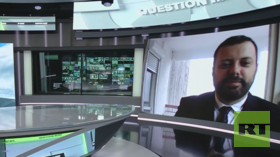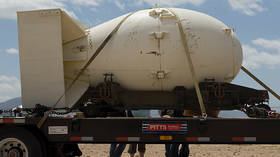Privatizing space? Strapped-for-cash NASA to open International Space Station to tourists
NASA, floundering under the weight of its promise to return to the Moon by 2024, has been forced to take on some extra work to pay the bills: playing host to private tourists aboard the International Space Station.
The US space agency has announced its section of the space station is open for business, available for leasing to private astronauts and commercial companies alike, starting as soon as next year. Not only will customers have access to space – they’ll even be able to use NASA’s astronauts for their commercial work, and use their technology to execute their projects – whether it’s a film shoot, an advertisement, or perhaps the world’s most expensive birthday party.
Use of the ISS won’t be cheap, of course – that would defeat the purpose. A “mission,” lasting no more than 30 days, will reportedly cost over $50 million. While NASA will only send up two private missions per year, the money adds up quickly and would go a long way toward filling the ever-widening void left as the Trump administration’s interest in returning to the Moon wanes.
For all of the money we are spending, NASA should NOT be talking about going to the Moon - We did that 50 years ago. They should be focused on the much bigger things we are doing, including Mars (of which the Moon is a part), Defense and Science!
— Donald J. Trump (@realDonaldTrump) June 7, 2019
NASA has struggled to keep up with private space companies like SpaceX and Blue Origin, which are wholly unconstrained by the vicissitudes of government budgets and free to commercialize their every move. Until its announcement on Thursday that it was flinging the ISS’ doors open to the (very wealthy) public, NASA did not allow anything without an educational or research component aboard – certainly not private visitors – and its “welcome” video is somewhat disorienting.
.@Space_Station is open for commercial business! Watch @Astro_Christina talk about the steps we're taking to make our orbiting laboratory accessible to all Americans. pic.twitter.com/xLp2CpMC2x
— NASA (@NASA) June 7, 2019
“Enabling a vibrant economy in low-earth orbit has always been a driving element of the space-station program,” astronaut Christina Koch says, promising that the new, privatized NASA “will make space more accessible to all Americans.”
Unlike the old government-funded Moon missions, the new and improved NASA will send “private astronauts” to the ISS on privately-funded dedicated flights operated by companies like SpaceX and Boeing, using US spacecraft as transportation; NASA hopes that as these voyages become more frequent, their operators will develop better and cheaper technology.
Unsurprisingly the news that space travel will be accessible to “all Americans” sparked quite a reaction on Twitter. “Do you really want to do that? Most Americans can’t even function on the ground,” Hugh Strudy joked, while John Pipkin wondered if he could use his Capital One rewards miles on a flight to space. However, the bulk of the reaction was people pointing out that space travel would surely be far too expensive for the vast majority. Several also wondered why NASA had limited travel to just Americans.
All Americans? Assuming of course you pay for your own air fare (99.999% of Americans immediately excluded). 'Accessible to incredibly rich Americans'.
— David McCaffery (@BusiArchitect) June 7, 2019
🤔 I’m glad she mentioned Americans because I live in Mexico, but Africans, Europeans, Asiatics and Oceanians are not welcome? 🤷🏻♂️ pic.twitter.com/gd3gyJlGfm
— Pata de Gato TV® (@PataDeGatoTV) June 8, 2019
Eventually, NASA suggests, the ISS will merely be an outpost en route to a series of “gateways” floating near the Moon and later Mars, and they plan to make one port of the ISS available to private companies for commercial purposes, hoping to trigger the creation of dozens of “private space stations” in Low-Earth Orbit.
NASA’s attempt to formulate a plan to return to the Moon in 2024 without selling itself to the highest bidder crashed and burned last month, forcing the resignation of project special assistant Mark Sirangelo after Congress declined to supply the agency with the funds it would have needed to reach the Moon.
Also on rt.com NASA exec in charge of Artemis moon mission quits after just 6 weeks, ‘escorted out of HQ’But despite the brave face NASA chief Jim Bridenstine has put on the new, privatized NASA, he continues to avoid any estimates of the project’s total cost, and the scale of crass commercialism he’s suddenly embraced – allowing companies to buy the naming rights to rockets, for example – suggests the number is quite large indeed.
Which doesn’t bode well for the future of the program as, according to his Twitter feed, President Trump is already bored with the Moon and has moved on to Mars.
Like this story? Share it with a friend!














